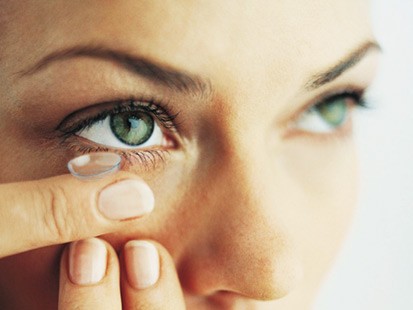
Contact lenses may give better looks to a person but the consequences of the extended wear of contact lenses can cause serious damages to the eye. According to a survey, about 6% of the contact lens users suffer from complications in U.S. The permeability of the cornea also gets affected resulting in inflammation and polymegathism in the corneal epithelium. Contact lens mishandling leads to abrasions of the cornea which progresses to keratitis and reduced corneal sensitivity. However, most of the changes to cornea due to the contact lenses are not permanent and are reversible with some exceptions in some cases.
Microbial keratitis
Microbial keratitis is one of the most severe corneal damages caused by wearing contact lenses. Microbial keratitis can cause permanent vision loss even though its occurrence is not very high. It is caused by the gram-negative pseudomonas and gram-positive staphylococcus bacteria. The symptoms of the microbial keratitis include severe pain, tearing and foreign body sensation. The aftermaths of infection causes irregular astigmatism and corneal scarring. This condition needs medical supervision as the patient can become visually impaired. If the corneal damage is on the higher side, then a corneal transplant is the only option for treatment. However, early detection of microbial keratitis can be treated by fortified topical antibiotics also. Specific antibiotics are given for different microbes causing the keratitis. After recovery, one can return to the use of contact lenses under medical supervision.
Corneal edema
Prolonged use of contact lenses results in swelling of the corneal portion of the eye. Studies show that women are more susceptible to corneal edema than men. Development of epithelial microcysts and increase in stromal thickness happens due to the corneal edema. The chronic edema symptoms include eye discomfort, foreign body sensation, halos around eyes and photophobia. It is necessary to diagnose corneal edema at early stage because the later stages worsen the condition causing stromal edema and intercellular epithelial edema. The recommended treatment includes antibiotics with anti-inflammatory drops. Proper eye care along with proper contact lenses are advised to avoid any kind of corneal edema problems in future.
Peripheral corneal infiltrates
Also known as contact lens associated corneal infiltrates (CLACI), this is a condition where cornea is infiltrated by inflammatory cells, caused due to contact lenses infection. In response to the infection of the cornea, inflammatory cells enter to fight against toxins or microbes inside the cornea. Infected sclera or an infected conjunctiva is the cause for CLACI. The patient’s condition in this case is painful and very uncomfortable. The identification of the cause of the infiltration peripheral is very important for its treatment as infiltration has other causes too. Topical antibiotics are given for 24-48 hours and even steroids are given if the condition persists. Eyes are cleansed with lid cleanser or by other recommended eye cleansers.
Corneal endothelium
The function of the endothelium is to maintain the corneal hydration levels in the normal zone which is very important to keep the transparency of the cornea intact. As contact lenses restrict the oxygen and water to the cornea, the contact lens initiates brief as well as permanent physical damage to the endothelium of cornea. One of the worst morphological changes due to contact lenses is polymegathism, which is a disorder in the cell size variation inside the endothelial monolayer. The medical treatment for the damaged cornea endothelium is not available, however the damaged corneal endothelium can be treated by corneal transplantation.
Acanathamoebic keratitis
Acanathamoebic keratitis is the condition where the cornea gets infected by the pathogenic protozoa acanthamoeb. The pathogen protozoan acanthamoeb causes the keratitis and it is present in contaminated air, soil, and even water. This disorder is common among people who wear soft contact lenses. It is also common among those people who swim with lenses in their eyes and those who make their own saline solutions at home. It damages the corneal tissue and the sclera of the eye. It can be treated with a combination of topical antimoebic and topical steroids but the treatment is lengthy. The patient is advised to avoid non-sterile solutions and go for proper care of the lens.
Red eye
Red eye condition, clinically known as contact lens-induced acute red eye (CLARE) is caused by the extended wearing of the contact lenses. It is an acute inflammatory response against the extended wear of hydrogel lenses. It causes extreme photophobia and severe pain with copious tearing. The symptoms of the CLARE are similar to that of the keratitis and the first step for the treatment of CLARE is the immediate discontinuation of the contact lens wear. It requires urgent treatment because infectious red eye can spread very quickly. Antibacterial and anti-fungal treatment is given to the patient. Recovery time is usually two weeks which alters with the patient’s complexity of the condition. Long term visual damages can be prevented by treating the red eye condition at the early stage.
Tight lens syndrome
As the name suggests, it is a condition when the lens loses its moisture and becomes somewhat dry. The lens after drying doesn’t fit in the eye properly and starts to squeeze the cornea. The lens stop moving even on blinking causing a great discomfort and it leads to irritation, pain and blurred vision. Long term persistence of this syndrome causes epithelial damage with anterior chamber reaction. The patient is advised to discontinue the use of contact lenses until the condition gets better. Tight lens syndrome requires medical attention and this syndrome is treated by the doses of topical antibiotics and steroids. Another effective substance for this syndrome is cyclopedic agents which are prescribed by some doctors.




